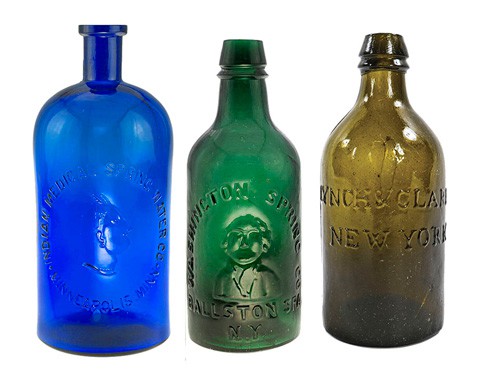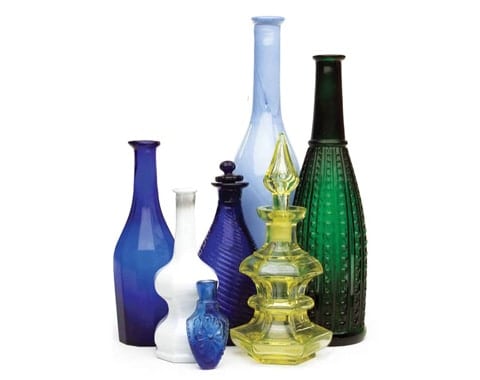WHAT DOES THE FUTURE HAVE IN STORE?
Growth and Expansion of The FOHBC Virtual Museum
The FOHBC Virtual Museum will be like any ‘bricks and mortar’ museum coupled with a backlog of images, research material, rotating exhibitions of historical significance and ever-expanding galleries, a gift shop, research library, and hall of honor etc.
As technology progresses, so will our endeavors; but the mission will remain the same. Museum functions cannot be maintained or expanded without your support. See how you can Give to the FOHBC Virtual Museum here.
The FOHBC Virtual Museum proudly opened at the beginning of 2020 with two unique Galleries, Bitters and Historical Flasks.
The category for Bitters, our first gallery, has eighty-six (86) wonderful examples on shelves for your viewing. Each bottle has support material and information. Many of the initial examples come from Sandor P. Fuss, Ferdinand Meyer V, Richard T. Siri and David Sidelinger. Ferdinand Meyer V is providing primary research using the Carlyn Ring and Bill Ham Bitters Bottles books. Ferdinand is also referencing the Peachridge Glass website.
Our second gallery is for Historical Flasks which was one of the first groups imaged. So far, we have one hundred and six (106) exquisite flasks on shelves. Many of the images have been taken from the top collections in the country. Historical flask authority, Mark Vuono, and others are helping with research. We are referencing the George S. and Helen McKearin American Glass book, the Blaske Collection book and the archives of Norman C. Heckler & Company.
The following galleries are now open for viewing:
- Spirits Gallery. Includes seventy-six (76) specimens.
- Jars Gallery. Includes one hundred and twenty-seven (127) jars.
- Target Balls Gallery. Includes fifty-four (54) target balls.
- Soda Water Gallery. Includes fifty-three (53) specimens.
- Food & Sauces Gallery. Includes thirty (30) specimens.
- Medicines Gallery. Includes forty-seven (47) specimens.
- Free Blown & Pattern Molded Gallery. Includes twenty-seven (27) specimens.
We are also building out the other galleries and have many examples ready for public review. We will be continuously adding specimens to all galleries.
See plans for upcoming Galleries below.
Coming Soon
See the upcoming Galleries below
Gallery #3
Our spirits gallery which includes whiskies, bourbons, gins etc. is being researched by Eric McGuire. Many of our initial bottles come from the great Richard T. Siri collection. This is our third gallery. Eric is moving forward nicely and we are looking good here. Eric, as some of you know, is a first rate researcher who has written many articles for Bottles and Extras. We are also referring to Whiskey Bottles of the Old West by John L. Thomas.
Gallery #4
Our fourth gallery is jars. We are working with Jerry McCann and referring to his Fruit Jar Annual books, Greg Spurgeon and his web site North American Glass and Douglas M. Leybourne and his Red Book Guides. We have imaged many jars and will be working to complete the gallery.
Gallery #5
Target Balls and related information, our fifth gallery, is being furnished primarily by Ralph Finch and from the Target Ball auction catalogs by John Pastor with American Glass Gallery. The spinners are in deep development and we are confident with our resources for information.
Gallery #6
Gallery #7
Gallery #8
There is also a good book on Western blob sodas by the Markotas that has the history of the bottles that includes names, dates and places or origin. This has been a nice group to spin for our eighth gallery which also includes Eastern, Midwestern and Southern sodas.
Gallery #9
Gallery #10
This grouping of bottles is bound together because they were primarily intended for products, not intended for internal human consumption. Content possibilities for some of the more generic bottles were virtually limitless…
Gallery #11
Fire extinguishers were a type of bottle designed to be filled with carbon tetrachloride—a fire retardant and thrown into fires to extinguish them. There were the early “fire extinguishers” as we know them today…
Gallery #12
Gallery #13
The free-blown gallery contains examples of early or colonial American glass blown with the assistance of a mold and with the use only of a blowpipe and punty. The glassware is shaped solely by inflation with a blowpipe and manipulation with tools. Pattern molded glassware is typically blown into a mold whose interior has a raised pattern…
Gallery #14
Blown Three Mold represents glassware made in America between 1815 and 1835 that was blown in a full-size mold despite the popular name consisting of between two and five pieces…
Gallery #15
This non-food-related household bottle gallery comprises the “catch-all” sections for bottle types that are not otherwise covered by the other major bottle type categories. Specifically, this page addresses non-food products clearly used in households, such as blacking, bluing, machine oil, shoe polish, snuff, tobacco, tooth wash, and other bottles that might be found around a house…
Gallery #16
Perfume, Cologne, and Toilet Water Bottles as a group come in a variety of shapes and sizes. This group of bottles is often referred to as simply “Scent Bottles,” although historically, there was a difference between perfume and scent…
Gallery #17
Ales and Beers—and related Stout, Porter, and Weiss—are the yeast fermented products of various grains like malted barley and/or wheat, which was most common. All four of these very similar products are lumped together and referred to simply as “Ales & Beers” in this gallery…
Gallery #18
Soda Pop
Coming soon! More information in the near future.


Gallery #19
Lightning Rod Balls
Coming soon! More information in the near future.
Gallery #20
The latter half of the 19th century was an era when little was correctly known about diseases and medical care. Manufacturers consequently took advantage of a lucrative opportunity and concocted nostrums that frequently were neither safe nor effective. At the forefront of these deceptive products were the embossed cures…
Gallery #21
Druggist or pharmacy, drugstore or prescription bottles have a close connection to the other types of medicinal bottles. Most of the many thousands of local druggists during the 19th and early 20th century typically concocted their own medicinal compounds to sell from their stores utilizing proprietary druggist or prescription bottles with the druggist or store name, address, city and state, and–or other information or a graphic feature…
STAY TUNED
MANY MORE TO COME!
LET'S MAKE IT OFFICIAL

















